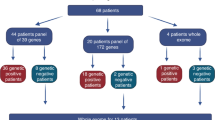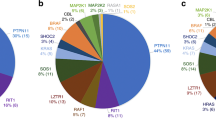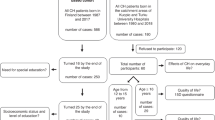Abstract
Background
Despite improved health, shorter stature is common in cystic fibrosis (CF). We aimed to describe height velocity (HV) and contribution of height-related genetic variants to height (HT) in CF.
Methods
HV cohort: standard deviation scores (-Z) for HT, mid-parental height-adjusted HT (MPAH), and HV were generated using our Pediatric Center’s CF Foundation registry data. HV-Z was compared with population means at each age (5–17 y), the relationship of HV-Z with HT-Z assessed, and HT-Z compared with MPAH-Z. GRS cohort: HT genetic risk-Z (HT-GRS-Z) were determined for pancreatic exocrine sufficient (PS) and insufficient (PI) youth and adults from our CF center and their relationships with HT-Z assessed.
Results
HV cohort: average HV-Z was normal across ages in our cohort but was 1.5× lower (p < 0.01) for each SD decrease in HT-Z. MPAH-Z was lower than HT-Z (p < 0.001). GRS cohort: HT-GRS-Z more strongly correlated with HT-Z and better explained height variance in PS (rho = 0.42; R2= 0.25) vs. PI (rho = 0.27; R2 = 0.11).
Conclusions
Despite shorter stature compared with peers and mid-parental height, youth with CF generally have normal linear growth in mid- and late childhood. PI tempered the heritability of height. These results suggest that, in CF, final height is determined early in life in CF and genetic potential is attenuated by other factors.
Impact
-
Children with CF remain shorter than their healthy peers despite advances in care.
-
Our study demonstrates that children with CF have persistent shorter stature from an early age and fail to reach their genetic potential despite height velocities comparable to those of average maturing healthy peers and similar enrichment in known height increasing single-nucleotide polymorphisms (SNPs).
-
Genetic risk scores better explained variability in pancreatic sufficient than in pancreatic insufficient individuals, suggesting that other modifying factors are in play for pancreatic insufficient individuals with CF.
-
Given the CF Foundation’s recommendation to target not only normal body mass index, but normal height percentiles as well, this study adds valuable insight to this discussion.
Similar content being viewed by others
Log in or create a free account to read this content
Gain free access to this article, as well as selected content from this journal and more on nature.com
or
References
Corey, M., McLaughlin, F. J., Williams, M. & Levison, H. A comparison of survival, growth, and pulmonary function in patients with cystic fibrosis in Boston and Toronto. J. Clin. Epidemiol. 41, 583–591 (1988).
Borowitz, D., Baker, R. D. & Stallings, V. Consensus report on nutrition for pediatric patients with cystic fibrosis. J. Pediatr. Gastroenterol. Nutr. 35, 246–259 (2002).
Blackman, S. M. & Tangpricha, V. Endocrine disorders in cystic fibrosis. Pediatr. Clin. North Am. 63, 699–708 (2016).
Landon, C. & Rosenfeld, R. G. Short stature and pubertal delay in male adolescents with cystic fibrosis. Androgen treatment. Am. J. Dis. Child 138, 388–391 (1984).
Davis, P. B. & Byard, P. J. Heterozygotes for cystic fibrosis: models for study of airway and autonomic reactivity. J. Appl. Physiol. 66, 2124–2128 (1989).
Barkhouse, L. B., Fahey, J., Gillespie, C. T. & Cole, D. E. Quantitating the effect of cystic fibrosis on linear growth by mathematical modelling of longitudinal growth curves. Growth Dev. Aging 53, 185–190 (1989).
Zhang, Z., Lindstrom, M. J. & Lai, H. J. Pubertal height velocity and associations with prepubertal and adult heights in cystic fibrosis. J. Pediatr. 163, 376–382 (2013).
Bournez, M., Bellis, G. & Huet, F. Growth during puberty in cystic fibrosis: a retrospective evaluation of a French cohort. Arch. Dis. Child 97, 714–720 (2012).
Zhang, Z., Lindstrom, M. J., Farrell, P. M. & Lai, H. J., Wisconsin Cystic Fibrosis Neonatal Screening G. Pubertal height growth and adult height in cystic fibrosis after newborn screening. Pediatrics 137, e20152907 (2016).
Kelly, A. et al. Age-based reference ranges for annual height velocity in US children. J. Clin. Endocrinol. Metab. 99, 2104–2112 (2014).
Yang, J. et al. Common SNPs explain a large proportion of the heritability for human height. Nat. Genet. 42, 565 (2010).
Visscher, P. M., Yang, J. & Goddard, M. E. A commentary on ‘common SNPs explain a large proportion of the heritability for human height’ by Yang et al. (2010). Twin Res. Hum. Genet 13, 517–524 (2010).
Yengo, L. et al. Meta-analysis of genome-wide association studies for height and body mass index in approximately 700000 individuals of European ancestry. Hum. Mol. Genet. 27, 3641–3649 (2018).
Kuczmarski R. J. et al. 2000 CDC growth charts: United States. Adv Data:1–27.
Lawman, H. G. et al. Comparing methods for identifying biologically implausible values in height, weight, and body mass index among youth. Am. J. Epidemiol. 182, 359–365 (2015).
Himes, J. H., Roche, A. F., Thissen, D. & Moore, W. M. Parent-specific adjustments for evaluation of recumbent length and stature of children. Pediatrics 75, 304–313 (1985).
Zhang, Z., Shoff, S. M. & Lai, H. J. Incorporating genetic potential when evaluating stature in children with cystic fibrosis. J. Cyst. Fibros. 9, 135–142 (2010).
Purcell S. C., Christopher PLINK [1.9] www.cog-genomics.org/plink/1.9/.
Chang C. C. et al. Second-generation PLINK: rising to the challenge of larger and richer datasets. Gigascience 4:7 (2015).
Zemel, B. S. et al. Revised reference curves for bone mineral content and areal bone mineral density according to age and sex for black and non-black children: results of the bone mineral density in childhood study. J. Clin. Endocrinol. Metab. 96, 3160–3169 (2011).
Brazzale, D. J., Hall, G. L. & Pretto, J. J. Effects of adopting the new global lung function initiative 2012 reference equations on the interpretation of spirometry. Respiration 86, 183–189 (2013).
Lohr, J. M., Oliver, M. R. & Frulloni, L. Synopsis of recent guidelines on pancreatic exocrine insufficiency. United European. Gastroenterol. J. 1, 79–83 (2013).
Haeusler, G., Frisch, H., Waldhor, T. & Gotz, M. Perspectives of longitudinal growth in cystic fibrosis from birth to adult age. Eur. J. Pediatr. 153, 158–163 (1994).
Leung, D. H. et al. Effects of diagnosis by newborn screening for cystic fibrosis on weight and length in the first year of life. JAMA Pediatr. 171, 546–554 (2017).
Tanner J. M., Whitehouse R., Takaishi M.J. Aodic 1966 Standards from birth to maturity for height, weight, height velocity, and weight velocity: British children. I. 41:454 (1965).
Tanner, J. M. & Davies, P. S. Clinical longitudinal standards for height and height velocity for North American children. J. Pediatr. 107, 317–329 (1985).
Tanner, J. M., Whitehouse, R. H., Marubini, E. & Resele, L. F. The adolescent growth spurt of boys and girls of the Harpenden growth study. Ann. Hum. Biol. 3, 109–126 (1976).
Tanner, J. M. & Whitehouse, R. H. Clinical longitudinal standards for height, weight, height velocity, weight velocity, and stages of puberty. Arch. Dis. Child 51, 170–179 (1976).
Wong, S. C. et al. Growth and the growth hormone-insulin like growth factor 1 axis in children with chronic inflammation: current evidence, gaps in knowledge, and future directions. Endocr. Rev. 37, 62–110 (2016).
Hawkes, C. P. & Grimberg, A. Measuring growth hormone and insulin-like growth factor-I in infants: what is normal? Pediatr. Endocrinol. Rev. 11, 126–146 (2013).
Rogan, M. P. et al. Pigs and humans with cystic fibrosis have reduced insulin-like growth factor 1 (IGF1) levels at birth. Proc. Natl Acad. Sci. 107, 20571–20575 (2010).
Gohlke, B. C., Fahnenstich, H., Dame, C. & Albers, N. Longitudinal data for intrauterine levels of fetal IGF-I and IGF-II. Horm. Res. 61, 200–204 (2004).
Bizzarri, C. et al. Glucose tolerance affects pubertal growth and final height of children with cystic fibrosis. Pediatr. Pulmonol. 50, 144–149 (2015).
Sheikh, S. et al. Reduced β-cell secretory capacity in pancreatic-insufficient, but not pancreatic-sufficient, cystic fibrosis despite normal glucose tolerance. Diabetes 66, 134–144 (2017).
Bryant M. et al. Agreement between routine and research measurement of infant height and weight. BMJ 100, 4–29 (2015).
Acknowledgements
We would like to thank the subjects with CF for their participation, Russell Localio, PhD of the University of Pennsylvania Department of Biostatistics, Epidemiology and Informatics for assistance with the statistical analyses and Rahul Agarwal for assistance with genetic sample collection. This work was supported by grants from the Cystic Fibrosis Foundation (to A.K., M.R.R., and M.J.K.), Public Health Services Research Grants R01 DK97830 (to A.K. and M.R.R.) and R01 DK085212 (to S.F.A.G.), UL1 TR000003 (Penn and CHOP Clinical & Translational Research Centers) and the Daniel B. Burke Endowed Chair for Diabetes Research (S.F.A.G.). A component of the height GRS findings was presented at the North American Cystic Fibrosis Conference in 2017 as an oral platform presentation. Otherwise, data from this manuscript are not under review or published elsewhere.
Author information
Authors and Affiliations
Contributions
Zofia Zysman-Colman, Marissa J. Kilberg, Victor S. Harrison, Ronald C. Rubenstein and Andrea Kelly—all made substantial contributions to conception and design, acquisition of data, or analysis and interpretation of data, drafted the article or revised it critically for important intellectual content; and gave final approval of the version to be published. Alessandra Chesi, Struan F.A. Grant, Jonathan Mitchell, Saba Sheikh, Denis Hadjiliadis, Michael R. Rickels, all made substantial contributions to the analysis and interpretation of data, revised the article critically for important intellectual content; and gave final approval of the version to be published.
Corresponding author
Ethics declarations
Competing interests
The authors declare no competing interests.
Informed consent
The requirement for patient consent was waived by the Children’s Hospital of Philadelphia Institutional Review Board.
Additional information
Publisher’s note Springer Nature remains neutral with regard to jurisdictional claims in published maps and institutional affiliations.
Rights and permissions
About this article
Cite this article
Zysman-Colman, Z.N., Kilberg, M.J., Harrison, V.S. et al. Genetic potential and height velocity during childhood and adolescence do not fully account for shorter stature in cystic fibrosis. Pediatr Res 89, 653–659 (2021). https://doi.org/10.1038/s41390-020-0940-4
Received:
Revised:
Accepted:
Published:
Issue date:
DOI: https://doi.org/10.1038/s41390-020-0940-4



